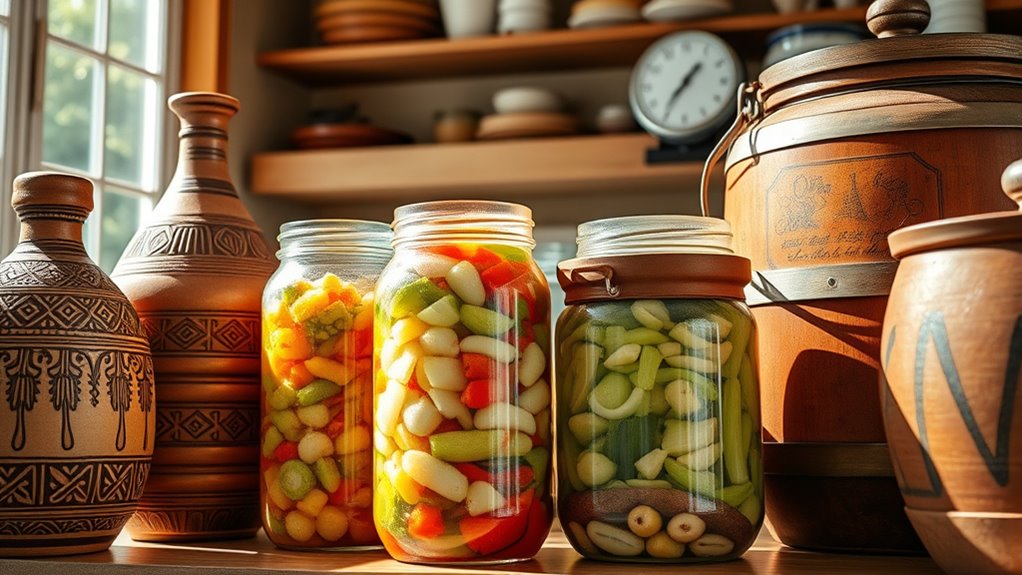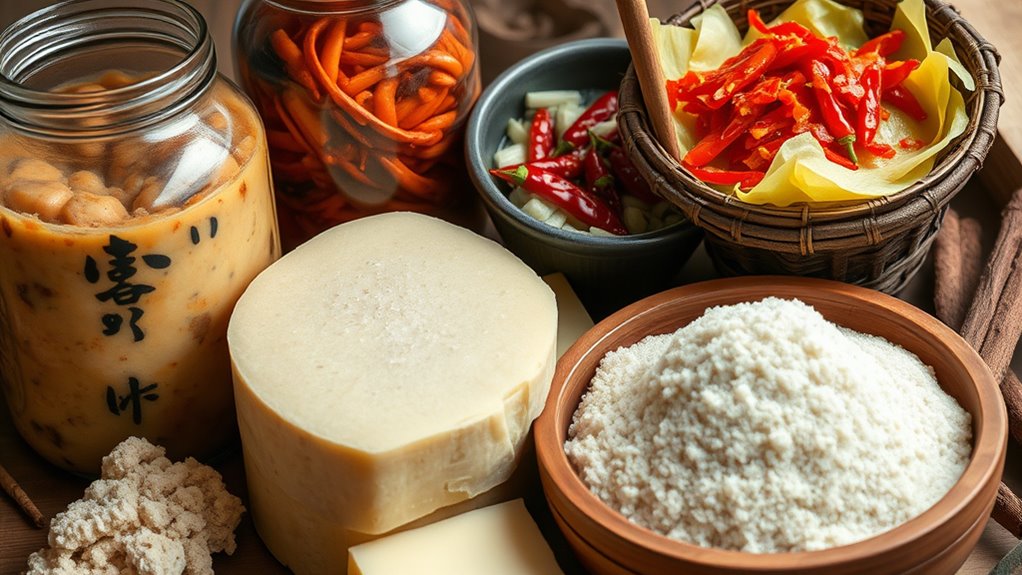Around the world, fermentation techniques vary widely and are deeply rooted in local cultures. You’ll find ways like Japanese miso, Korean kimchi, European sauerkraut, Ethiopian injera, and Middle Eastern fermented dairy products, all using natural microbes or starter cultures. These methods preserve ingredients, develop complex flavors, and boost nutrition. Each region’s climate and ingredients influence their unique approaches. If you’re curious, exploring these traditions reveals how fermentation connects us through shared food transformation methods.
Key Takeaways
- Diverse regional microbes and ingredients influence fermentation methods across Asia, Europe, Africa, and the Middle East.
- Traditional techniques often rely on natural microbes from the environment or starter cultures.
- Fermentation enhances flavor complexity, nutritional value, and preservation of foods like miso, sauerkraut, and injera.
- Cultural practices shape specific fermentation processes, reflecting regional tastes and culinary heritage.
- Slow, natural fermentation processes are integral to many food traditions worldwide, emphasizing patience and craftsmanship.

Have you ever wondered how different cultures transform simple ingredients into flavorful staples through fermentation? It’s fascinating how a process as basic as allowing natural microbes to work can create foods that define entire cuisines. When you explore various traditions, you’ll discover that fermentation isn’t just about preservation; it’s about unlocking layers of flavor, enhancing nutrition, and connecting with cultural heritage.
Each region has developed unique techniques suited to their climate, ingredients, and tastes, resulting in a rich tapestry of fermented foods that are both delicious and functional.
Unique regional techniques create a vibrant array of delicious, functional fermented foods worldwide.
In many parts of Asia, fermentation plays a central role in daily life. For example, in Japan, you might be familiar with miso, a fermented soybean paste that adds umami depth to soups and dishes. Making miso involves fermenting cooked soybeans with salt and a mold called koji, which breaks down proteins and starches into amino acids and sugars, creating complex flavors over months or even years.
Similarly, in Korea, kimchi stands out as a staple fermented vegetable, usually cabbage or radishes, seasoned with chili, garlic, and ginger before fermenting. The fermentation not only preserves the vegetables but also produces probiotics that boost gut health. These processes rely on natural microbes present in the environment or added starter cultures, which transform simple ingredients into tangy, savory foods.
Moving westward, Europe boasts a long tradition of fermenting dairy and vegetables. In Eastern Europe, sauerkraut is a common fermented cabbage, made by shredding cabbage and fermenting it with salt. The salt encourages the growth of beneficial bacteria while inhibiting spoilage organisms. The result is a crunchy, tangy condiment packed with probiotics.
Similarly, in the Mediterranean, you might find fermented olives, which undergo natural fermentation to develop their distinctive flavor. These techniques often involve brining or fermentation in saltwater, creating the ideal environment for beneficial microbes to flourish.
Across Africa and the Middle East, fermentation techniques are equally diverse. You might enjoy injera, a sourdough flatbread from Ethiopia, which is made from teff flour fermented for several days. This fermentation develops the bread’s characteristic sourness and leavening.
In the Middle East, fermented dairy products like laban and yogurt are common, created by fermenting milk with specific bacterial cultures. These foods not only add flavor but also serve as vital nutritional sources.
Interestingly, the microbial communities involved in fermentation vary widely depending on regional ingredients and practices, highlighting the importance of natural microbes in the process.
No matter where you look, fermentation unites cultures through a shared understanding: transforming humble ingredients into complex, healthful foods. It’s a slow, natural process that celebrates patience and tradition, resulting in staples that continue to nourish and delight across generations.
Frequently Asked Questions
What Safety Precautions Are Necessary During Fermentation?
When fermenting, you need to prioritize safety to prevent spoilage and harmful bacteria. Always clean your tools and containers thoroughly, and use fresh ingredients.
Keep your fermentation environment at a consistent, appropriate temperature.
Cover your jars securely but allow gases to escape.
Check your ferment regularly for mold or off smells, and discard anything suspicious.
Proper hygiene and monitoring guarantee your fermentation process is safe and successful.
How Does Climate Affect Fermentation Methods Globally?
Climate influences fermentation methods by dictating temperature control, humidity levels, and fermentation durations.
You adapt your techniques to warm, humid climates by using cool storage or fermentation in shaded areas, while colder regions require insulated containers and longer fermentation times.
In hot, dry environments, you might increase salt or acidity to preserve flavors.
Climate shapes your approach, ensuring safe, successful fermentation regardless of where you are.
Can Fermentation Techniques Be Adapted for Home Use?
You can definitely adapt fermentation techniques for home use. Start with simple recipes, like making yogurt, sauerkraut, or kombucha, which require minimal equipment. Follow clear instructions and maintain proper hygiene to guarantee safety.
Adjust ingredients and fermentation times based on your taste. With patience and practice, you’ll master the process, creating delicious, homemade fermented foods and drinks that are both healthy and satisfying.
What Are Common Fermentation Mistakes and How to Avoid Them?
Ever heard the saying, “a little knowledge is a dangerous thing”? When fermenting at home, common mistakes like poor hygiene, incorrect temperatures, and rushing the process can spoil your batch.
To avoid these pitfalls, sterilize your equipment, monitor temperatures carefully, and be patient.
Trust the process, and remember that patience and cleanliness are your best friends in achieving successful, tasty ferments.
How Do Traditional Fermentation Methods Influence Local Health?
Traditional fermentation methods greatly influence local health by preserving nutrients and promoting beneficial gut bacteria. When you follow these time-tested practices, you support digestion and boost immunity naturally.
These methods often use locally sourced ingredients, reducing reliance on processed foods. By practicing traditional fermentation, you help maintain cultural practices and improve overall well-being.
Embracing these techniques guarantees you enjoy healthier, flavorful foods that contribute positively to your community’s health.
Conclusion
As you explore fermentation techniques worldwide, you’ll see how this ancient practice connects cultures and preserves flavors. Fascinatingly, fermentation boosts food security: the global fermented food market is projected to reach $26 billion by 2026. By embracing diverse methods, you not only enjoy unique tastes but also support sustainable, nutritious eating habits. So, keep experimenting and appreciating these time-honored traditions—they’re more than just food, they’re a shared heritage.









